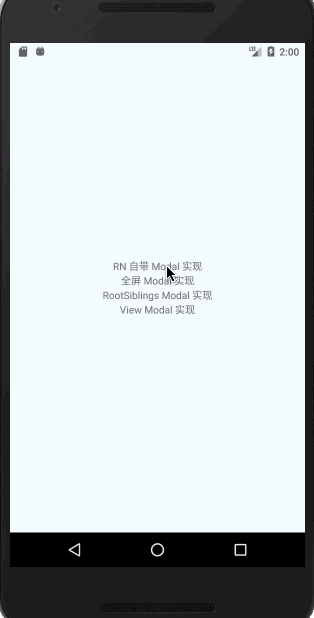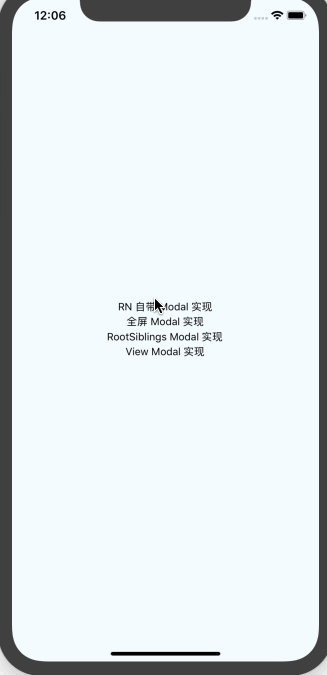React Native Modal 使用
wi100sh 人气:0背景
在使用 React Native(以下简称 RN ,使用版本为 0.59.5) 开发 App 的过程中,有许许多多使用到弹窗控件的场景,虽然 RN 自带了一个 Modal 控件,但是在使用过程中它有一些不太好的体验和问题。
- Android 端的 Modal 控件无法全屏,也就是内容无法从状态栏处开始布局。
- ios 端的 Modal 控件的层级太高,是基于 window 的,如果在 Modal 中打开一个新的 ViewController 界面的时候,将会被 Modal 控件给覆盖住,同时 ios 的 Modal 控件只能弹出一个。
针对上面所发现的问题,我们需要对 RN 的 Modal 控件整体做一个修改和封装,以便于在使用中可以应对各种不同样的业务场景。
Android FullScreenModal 的封装使用
针对第一个问题,查看了 RN Modal 组件在 Android 端的实现,发现它是对 Android Dialog 组件的一个封装调用,那么假如我能实现一个全屏展示的 Dialog,那么是不是在 RN 上也就可以实现全屏弹窗了。
Android 原生实现全屏 Dialog
FullScreenDialog 主要实现代码如下
public class FullScreenDialog extends Dialog {
private boolean isDarkMode;
private View rootView;
public void setDarkMode(boolean isDarkMode) {
this.isDarkMode = isDarkMode;
}
public FullScreenDialog(@NonNull Context context, @StyleRes int themeResId) {
super(context, themeResId);
}
@Override
public void setContentView(@NonNull View view) {
super.setContentView(view);
this.rootView = view;
}
@Override
public void show() {
super.show();
StatusBarUtil.setTransparent(getWindow());
if (isDarkMode) {
StatusBarUtil.setDarkMode(getWindow());
} else {
StatusBarUtil.setLightMode(getWindow());
}
AndroidBug5497Workaround.assistView(rootView, getWindow());
}
}在这里主要起作用的是 StatusBarUtil.setTransparent(getWindow()); 方法,它的主要作用是将状态栏背景透明,并且让布局内容可以从 Android 状态栏开始。
/**
* 使状态栏透明,并且是从状态栏处开始布局
*/
@TargetApi(Build.VERSION_CODES.KITKAT)
private static void transparentStatusBar(Window window) {
if (Build.VERSION.SDK_INT >= Build.VERSION_CODES.LOLLIPOP) {
View decorView = window.getDecorView();
int option = View.SYSTEM_UI_FLAG_LAYOUT_FULLSCREEN | View.SYSTEM_UI_FLAG_LAYOUT_STABLE;
decorView.setSystemUiVisibility(option);
window.setStatusBarColor(Color.TRANSPARENT);
} else {
window.addFlags(WindowManager.LayoutParams.FLAG_TRANSLUCENT_STATUS);
}
}这里需要注意的是,该方法只有在 Android 4.4 以上才会有效果,不过如今已经是 9012 年了,主流 Android 用户使用的版本应该没有低于 Android 4.4 了吧。
封装给 RN 进行相关的调用
Android 原生部分实现
有了 FullScreenDialog ,下一步就是封装组件给 RN 进行调用了,这里主要的步骤就是参考 RN Modal 的 Android 端实现,然后替换其中的 Dialog 为 FullScreenDialog,最后封装给 RN 进行调用。
public class FullScreenModalManager extends ViewGroupManager<FullScreenModalView> {
@Override
public String getName() {
return "RCTFullScreenModalHostView";
}
public enum Events {
ON_SHOW("onFullScreenShow"),
ON_REQUEST_CLOSE("onFullScreenRequstClose");
private final String mName;
Events(final String name) {
mName = name;
}
@Override
public String toString() {
return mName;
}
}
@Override
@Nullable
public Map getExportedCustomDirectEventTypeConstants() {
MapBuilder.Builder builder = MapBuilder.builder();
for (Events event : Events.values()) {
builder.put(event.toString(), MapBuilder.of("registrationName", event.toString()));
}
return builder.build();
}
@Override
protected FullScreenModalView createViewInstance(ThemedReactContext reactContext) {
final FullScreenModalView view = new FullScreenModalView(reactContext);
final RCTEventEmitter mEventEmitter = reactContext.getJSModule(RCTEventEmitter.class);
view.setOnRequestCloseListener(new FullScreenModalView.OnRequestCloseListener() {
@Override
public void onRequestClose(DialogInterface dialog) {
mEventEmitter.receiveEvent(view.getId(), Events.ON_REQUEST_CLOSE.toString(), null);
}
});
view.setOnShowListener(new DialogInterface.OnShowListener() {
@Override
public void onShow(DialogInterface dialog) {
mEventEmitter.receiveEvent(view.getId(), Events.ON_SHOW.toString(), null);
}
});
return view;
}
@Override
public LayoutShadowNode createShadowNodeInstance() {
return new FullScreenModalHostShadowNode();
}
@Override
public Class<? extends LayoutShadowNode> getShadowNodeClass() {
return FullScreenModalHostShadowNode.class;
}
@Override
public void onDropViewInstance(FullScreenModalView view) {
super.onDropViewInstance(view);
view.onDropInstance();
}
@ReactProp(name = "autoKeyboard")
public void setAutoKeyboard(FullScreenModalView view, boolean autoKeyboard) {
view.setAutoKeyboard(autoKeyboard);
}
@ReactProp(name = "isDarkMode")
public void setDarkMode(FullScreenModalView view, boolean isDarkMode) {
view.setDarkMode(isDarkMode);
}
@ReactProp(name = "animationType")
public void setAnimationType(FullScreenModalView view, String animationType) {
view.setAnimationType(animationType);
}
@ReactProp(name = "transparent")
public void setTransparent(FullScreenModalView view, boolean transparent) {
view.setTransparent(transparent);
}
@ReactProp(name = "hardwareAccelerated")
public void setHardwareAccelerated(FullScreenModalView view, boolean hardwareAccelerated) {
view.setHardwareAccelerated(hardwareAccelerated);
}
@Override
protected void onAfterUpdateTransaction(FullScreenModalView view) {
super.onAfterUpdateTransaction(view);
view.showOrUpdate();
}
}在这里有几点需要注意的
- 由于 RN Modal 已经存在了 onShow 和 onRequestClose 回调,这里不能再使用这两个命名,所以这里改成了 onFullScreenShow 和 onFullScreenRequstClose,但是在 js 端还是重新命名成 onShow 和 onRequestClose ,所以在使用过程中还是没有任何变化
- 增加了 isDarkMode 属性,对应上面的状态栏字体的颜色
- 增加了 autoKeyboard 属性,根据该属性判断是否需要自动弹起软件盘
其他的一些属性和用法也就跟 RN Modal 的一样了。
JS 部分实现
在 JS 部分,我们只需要 Android 的实现就好了,ios 还是沿用原来的 Modal 控件。这里参照 RN Modal 的 JS 端实现如下
import React, {Component} from "react";
import {requireNativeComponent, View} from "react-native";
const FullScreenModal = requireNativeComponent('RCTFullScreenModalHostView', FullScreenModalView)
export default class FullScreenModalView extends Component {
_shouldSetResponder = () => {
return true;
}
render() {
if (this.props.visible === false) {
return null;
}
const containerStyles = {
backgroundColor: this.props.transparent ? 'transparent' : 'white',
};
return (
<FullScreenModal
style={{position: 'absolute'}} {...this.props}
onStartShouldSetResponder={this._shouldSetResponder}
onFullScreenShow={() => this.props.onShow && this.props.onShow()}
onFullScreenRequstClose={() => this.props.onRequestClose && this.props.onRequestClose()}>
<View style={[{position: 'absolute', left: 0, top: 0}, containerStyles]}>
{this.props.children}
</View>
</FullScreenModal>
)
}
}
使用 RootSiblings 封装 Modal
针对第二个问题,一种方法是通过 ios 原生去封装实现一个 Modal 控件,但是在 RN 的开发过程中,发现了一个第三方库 react-native-root-siblings , 它重写了系统的 AppRegistry.registerComponent 方法,当我们通过这个方法注册根组件的时候,替换根组件为我们自己的实现的包装类。包装类中监听了目标通知 siblings.update,接收到通知就将通知传入的组件视图添加到包装类顶层,然后进行刷新显示。通过 RootSiblings 也可以实现一个 Modal 组件,而且它的层级是在当前界面的最上层的。
实现界面 Render 相关
由于 RootSiblings 的实现是通过将组件添加到它注册到根节点中的,并不直接通过 Component 的 Render 进行布局,而 RN Modal 的显示隐藏是通过 visible 属性进行控制,所以在 componentWillReceiveProps(nextProps) 中根据 visible 进行相关的控制,部分实现代码如下
render() {
if (this.props.visible) {
this.RootSiblings && this.RootSiblings.update(this.renderRootSiblings());
}
return null;
}
componentWillReceiveProps(nextProps) {
const { onShow, animationType, onDismiss } = this.props;
const { visible } = nextProps;
if (!this.RootSiblings && visible === true) { // 表示从没有到要显示了
this.RootSiblings = new RootSiblings(this.renderRootSiblings(), () => {
if (animationType === 'fade') {
this._animationFadeIn(onShow);
} else if (animationType === 'slide') {
this._animationSlideIn(onShow);
} else {
this._animationNoneIn(onShow);
}
});
} else if (this.RootSiblings && visible === false) { // 表示显示之后要隐藏了
if (animationType === 'fade') {
this._animationFadeOut(onDismiss);
} else if (animationType === 'slide') {
this._animationSlideOut(onDismiss);
} else {
this._animationNoneOut(onDismiss);
}
}
}实现 Modal 展示动画相关
RN Modal 实现了三种动画模式,所以这里在通过 RootSiblings 实现 Modal 组件的时候也实现了这三种动画模式,这里借助的是 RN 提供的 Animated 和 Easing 进行相关的实现
- ‘none’ 这种不必多说,直接进行展示,没有动画效果
- ‘fade’ 淡入浅出动画,也就是透明度的一个变化,这里使用了 Easing.in 插值器使得效果更加平滑
- ‘slide’ 幻灯片的滑入画出动画,这是是组件 Y 方向位置的一个变化,这里使用了 Easing.in 插值器使得效果更加平滑
完整的一个 使用 RootSiblings 封装 Modal 实现代码如下
import React, { Component } from 'react';
import {
Animated, Easing, Dimensions, StyleSheet,
} from 'react-native';
import RootSiblings from 'react-native-root-siblings';
const { height } = Dimensions.get('window');
const animationShortTime = 250; // 动画时长为250ms
export default class ModalView extends Component {
constructor(props) {
super(props);
this.state = {
animationSlide: new Animated.Value(0),
animationFade: new Animated.Value(0),
};
}
render() {
if (this.props.visible) {
this.RootSiblings && this.RootSiblings.update(this.renderRootSiblings());
}
return null;
}
componentWillReceiveProps(nextProps) {
const { onShow, animationType, onDismiss } = this.props;
const { visible } = nextProps;
if (!this.RootSiblings && visible === true) { // 表示从没有到要显示了
this.RootSiblings = new RootSiblings(this.renderRootSiblings(), () => {
if (animationType === 'fade') {
this._animationFadeIn(onShow);
} else if (animationType === 'slide') {
this._animationSlideIn(onShow);
} else {
this._animationNoneIn(onShow);
}
});
} else if (this.RootSiblings && visible === false) { // 表示显示之后要隐藏了
if (animationType === 'fade') {
this._animationFadeOut(onDismiss);
} else if (animationType === 'slide') {
this._animationSlideOut(onDismiss);
} else {
this._animationNoneOut(onDismiss);
}
}
}
renderRootSiblings = () => {
return (
<Animated.View style={[styles.root,
{ opacity: this.state.animationFade },
{
transform: [{
translateY: this.state.animationSlide.interpolate({
inputRange: [0, 1],
outputRange: [height, 0],
}),
}],
}]}>
{this.props.children}
</Animated.View>
);
}
_animationNoneIn = (callback) => {
this.state.animationSlide.setValue(1);
this.state.animationFade.setValue(1);
callback && callback();
}
_animationNoneOut = (callback) => {
this._animationCallback(callback);
}
_animationSlideIn = (callback) => {
this.state.animationSlide.setValue(0);
this.state.animationFade.setValue(1);
Animated.timing(this.state.animationSlide, {
easing: Easing.in(),
duration: animationShortTime,
toValue: 1,
}).start(() => callback && callback());
}
_animationSlideOut = (callback) => {
this.state.animationSlide.setValue(1);
this.state.animationFade.setValue(1);
Animated.timing(this.state.animationSlide, {
easing: Easing.in(),
duration: animationShortTime,
toValue: 0,
}).start(() => this._animationCallback(callback));
}
_animationFadeIn = (callback) => {
this.state.animationSlide.setValue(1);
this.state.animationFade.setValue(0);
Animated.timing(this.state.animationFade, {
easing: Easing.in(),
duration: animationShortTime,
toValue: 1,
}).start(() => callback && callback());
}
_animationFadeOut = (callback) => {
this.state.animationSlide.setValue(1);
this.state.animationFade.setValue(1);
Animated.timing(this.state.animationFade, {
easing: Easing.in(),
duration: animationShortTime,
toValue: 0,
}).start(() => this._animationCallback(callback));
}
_animationCallback = (callback) => {
this.RootSiblings && this.RootSiblings.destroy(() => {
callback && callback();
this.RootSiblings = undefined;
});
}
}
const styles = StyleSheet.create({
root: {
position: 'absolute',
left: 0,
top: 0,
right: 0,
bottom: 0,
},
});使用 View 封装 Modal
上面两种 Modal 的封装已经能够满足绝大部分业务场景的需求,但是如果在 Modal 中需要打开新的界面(不创建新的 ViewController 和 Acticity ),并且 Modal 不进行隐藏的话,比如使用 react-navigation 跳转页面,那么上面实现的 Modal 层级会太高了。所以这里通过 View 去实现类似的一个 Modal 控件。它的实现代码类似于上面的 RootSiblings 的实现。在 Render 中进行展示就好了,动画也可以使用上面的实现
render() {
return this._renderView()
}
_renderView = () => {
if (this.state.visible) {
return (
<Animated.View style={[styles.root,
{opacity: this.state.animationFade},
{
transform: [{
translateY: this.state.animationSlide.interpolate({
inputRange: [0, 1],
outputRange: [height, 0]
}),
}]
}]}>
{this.props.children}
</Animated.View>
);
} else {
return null
}
}整体 Modal 控件的封装
相对于 RN Modal ,上面新增了三种 Modal 的实现,为了整合整体的使用,所以需要对它们进行一个整体的封装使用,通过制定 modalType 的方式,来指定我们需要它内部的实现,先上代码
/**
* @Author: linhe
* @Date: 2019-05-12 10:11
*
* 因为ios端同时只能存在一个Modal,并且Modal多次显示隐藏会有很奇怪的bug
*
* 为了兼容ios的使用,这里需要封装一个ModalView
*
* Android 依旧使用 React Native Modal 来进行实现
* ios 的话采用 RootSiblings 配合进行使用
*
* 这个是因为有的modal里面还需要跳转到其他界面
* 这个时候主要要将该View放到最外边的层级才可以
*
* modalType:1 //表示使用Modal进行实现
* 2 //表示使用RootSiblings进行实现
* 3 //表示使用View进行实现
* 注意:默认情况下 Android 使用的是1,ios使用的是2
*
* 同时采用与 React Native Modal 相同的API
*/
'use strict';
import React, {Component} from "react";
import {Animated, BackHandler, Platform, Easing, StyleSheet, Dimensions, Modal} from "react-native";
import PropTypes from 'prop-types'
import RootSiblings from 'react-native-root-siblings';
import FullScreenModal from './FullScreenModal/FullScreenModal'
const {height} = Dimensions.get('window')
const animationShortTime = 250 //动画时长为250ms
const DEVICE_BACK_EVENT = 'hardwareBackPress';
export default class ModalView extends Component {
static propTypes = {
isDarkMode: PropTypes.bool, // false 表示白底黑字,true 表示黑底白字
autoKeyboard: PropTypes.bool, // 未知原因的坑,modal中的edittext自动弹起键盘要设置这个参数为true
useReactModal: PropTypes.bool, // 是否使用 RN Modal 进行实现
modalType: PropTypes.number // modalType 类型,默认 android 为 1,ios 为 2
};
static defaultProps = {
isDarkMode: false,
autoKeyboard: false,
useReactModal: false,
modalType: (Platform.OS === 'android' ? 1 : 2) // 默认 android 为1,ios 为2
};
constructor(props) {
super(props);
this.state = {
visible: false,
animationSlide: new Animated.Value(0),
animationFade: new Animated.Value(0)
};
}
render() {
const {modalType} = this.props
if (modalType === 1) { //modal实现
return this._renderModal()
} else if (modalType === 2) { //RootSiblings实现
this.RootSiblings && this.RootSiblings.update(this._renderRootSiblings())
return null
} else { //View的实现
return this._renderView()
}
}
_renderModal = () => {
const ModalView = this.props.useReactModal ? Modal : FullScreenModal
return (
<ModalView
transparent={true}
{...this.props}
visible={this.state.visible}
onRequestClose={() => {
if (this.props.onRequestClose) {
this.props.onRequestClose()
} else {
this.disMiss()
}
}}>
{this.props.children}
</ModalView>
)
}
_renderRootSiblings = () => {
return (
<Animated.View style={[styles.root,
{opacity: this.state.animationFade},
{
transform: [{
translateY: this.state.animationSlide.interpolate({
inputRange: [0, 1],
outputRange: [height, 0]
}),
}]
}]}>
{this.props.children}
</Animated.View>
);
}
_renderView = () => {
if (this.state.visible) {
return (
<Animated.View style={[styles.root,
{opacity: this.state.animationFade},
{
transform: [{
translateY: this.state.animationSlide.interpolate({
inputRange: [0, 1],
outputRange: [height, 0]
}),
}]
}]}>
{this.props.children}
</Animated.View>
);
} else {
return null
}
}
show = (callback) => {
if (this.isShow()) {
return
}
const {modalType, animationType} = this.props
if (modalType === 1) { //modal
this.setState({visible: true}, () => callback && callback())
} else if (modalType === 2) { //RootSiblings
this.RootSiblings = new RootSiblings(this._renderRootSiblings(), () => {
if (animationType === 'fade') {
this._animationFadeIn(callback)
} else if (animationType === 'slide') {
this._animationSlideIn(callback)
} else {
this._animationNoneIn(callback)
}
});
// 这里需要监听 back 键
this._addHandleBack()
} else { //view
if (animationType === 'fade') {
this.setState({visible: true}, () => this._animationFadeIn(callback))
} else if (animationType === 'slide') {
this.setState({visible: true}, () => this._animationSlideIn(callback))
} else {
this.setState({visible: true}, () => this._animationNoneIn(callback))
}
// 这里需要监听 back 键
this._addHandleBack()
}
}
disMiss = (callback) => {
if (!this.isShow()) {
return
}
const {modalType, animationType} = this.props
if (modalType === 1) { //modal
this.setState({visible: false}, () => callback && callback())
} else { //RootSiblings和View
if (animationType === 'fade') {
this._animationFadeOut(callback)
} else if (animationType === 'slide') {
this._animationSlideOut(callback)
} else {
this._animationNoneOut(callback)
}
// 移除 back 键的监听
this._removeHandleBack()
}
}
isShow = () => {
const {modalType} = this.props
if (modalType === 1 || modalType === 3) { //modal和view
return this.state.visible
} else { //RootSiblings
return !!this.RootSiblings
}
}
_addHandleBack = () => {
if (Platform.OS === 'ios') {
return
}
// 监听back键
this.handleBack = BackHandler.addEventListener(DEVICE_BACK_EVENT, () => {
const {onRequestClose} = this.props
if (onRequestClose) {
onRequestClose()
} else {
this.disMiss()
}
return true
});
}
_removeHandleBack = () => {
if (Platform.OS === 'ios') {
return
}
this.handleBack && this.handleBack.remove()
}
_animationNoneIn = (callback) => {
this.state.animationSlide.setValue(1)
this.state.animationFade.setValue(1)
callback && callback()
}
_animationNoneOut = (callback) => {
this._animationCallback(callback);
}
_animationSlideIn = (callback) => {
this.state.animationSlide.setValue(0)
this.state.animationFade.setValue(1)
Animated.timing(this.state.animationSlide, {
easing: Easing.in(),
duration: animationShortTime,
toValue: 1,
}).start(() => callback && callback());
}
_animationSlideOut = (callback) => {
this.state.animationSlide.setValue(1)
this.state.animationFade.setValue(1)
Animated.timing(this.state.animationSlide, {
easing: Easing.in(),
duration: animationShortTime,
toValue: 0,
}).start(() => this._animationCallback(callback));
}
_animationFadeIn = (callback) => {
this.state.animationSlide.setValue(1)
this.state.animationFade.setValue(0)
Animated.timing(this.state.animationFade, {
easing: Easing.in(),
duration: animationShortTime,
toValue: 1,
}).start(() => callback && callback());
}
_animationFadeOut = (callback) => {
this.state.animationSlide.setValue(1)
this.state.animationFade.setValue(1)
Animated.timing(this.state.animationFade, {
easing: Easing.in(),
duration: animationShortTime,
toValue: 0,
}).start(() => this._animationCallback(callback));
}
_animationCallback = (callback) => {
if (this.props.modalType === 2) {//RootSiblings
this.RootSiblings && this.RootSiblings.destroy(() => {
callback && callback()
this.RootSiblings = undefined
})
} else { //view
this.setState({visible: false}, () => callback && callback())
}
}
}
const styles = StyleSheet.create({
root: {
position: 'absolute',
left: 0,
top: 0,
right: 0,
bottom: 0,
}
});这里主要通过 useReactModal 和 modalType 两个属性来控制我们所需要的实现
- modalType 表示 modal 内部实现方式,1 表示使用层级较高的实现,2 表示使用 RootSiblings 进行实现,3 表示使用 View 进行实现,当不进行指定的时候,默认 Android 为 1,ios 为 2
- useReactModal 主要针对 Android 端并且 modalType 为 1 的时候使用,true 表示使用 RN Modal,false 表示使用 FullScreenModal ,默认为 false
- 对外提供 show,disMiss,isShow 方法分别表示显示弹窗,隐藏弹窗和判断当前弹窗的状态,同时在 show 和 disMiss 方法调用的时候还添加了 callback 回调
其他
Android Back 键的注意
当 Modal 组件使用 RootSiblings 或者 View 实现的时候,它并没有处理一个 Android 的返回键,所以对于这两种实现的时候,要额外处理一个 Back 键的操作,这里借助了 RN BackHandler 这个了,如果 modalType 不为 1 的话,需要通过 BackHandler 去实现一个返回键的监听,然后通过 onRequestClose 属性进行返回
const DEVICE_BACK_EVENT = 'hardwareBackPress';
_addHandleBack = () => {
if (Platform.OS === 'ios') {
return
}
// 监听back键
this.handleBack = BackHandler.addEventListener(DEVICE_BACK_EVENT, () => {
const {onRequestClose} = this.props
if (onRequestClose) {
onRequestClose()
} else {
this.disMiss()
}
return true
});
}
_removeHandleBack = () => {
if (Platform.OS === 'ios') {
return
}
this.handleBack && this.handleBack.remove()
}View 封装 Modal 时候的注意
如果是 View 实现的 Modal 控件,那必须要注意它的一个层级,必须满足它所处于整个界面布局的最外层,否则它可能会被其他组件所挡住,同时它的最大的显示范围取决于它的父 View 的显示范围。
最后
当然在最后还是要附上实现效果图


再一次附上 Demo 地址:https://github.com/hzl123456/ModalViewDemo
加载全部内容